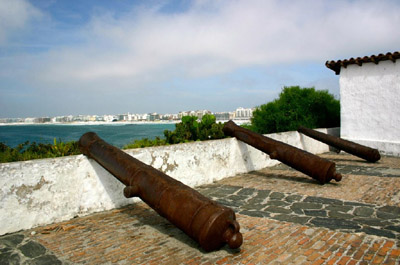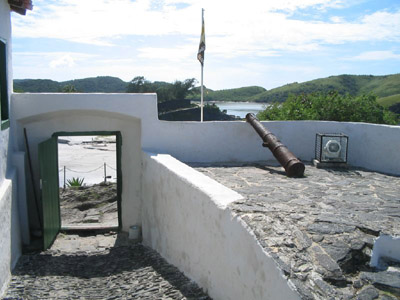 |
Forte de Sao Mateus
Cabo Frio, Brazil
|
|
 |
Rio de Janeiro was founded by the Portuguese in 1565, in their endless quest to pillage unsuspecting indigenous peoples. The Portuguese almost immediately found themselves beset by the usual variety of waterborne scalliwags who sailed about in that area, and recognized a need for both expansion and protection. About 70 miles east of Rio, the town of Cabo Frio was established on November 13 1615, at least partially as a means for the Portuguese to defend their holdings in depth.
The Forte de Santo Inacio was swiftly thrown up at Cabo Frio, but within two years the Governor of the state of Rio de Janiero, one Constantine Menelaus (1615-1617), declared the fort to be unfortunate, and decreed that a new fort should be built, preferably one that might actually protect something.
|
 |

|
|
The new forte was built in a more commanding position atop a little island just off the beach, and by 1620 it was operational, deterring no small amount of piratical rudeness. Once the Portuguese had wrested Angola with its lucrative slave markets from the Dutch in 1648, the decision was made to remove the Forte de Sao mateus' cannon and garrison, leaving Cabo Frio's 24 residents defenseless. By 1650 cannon were returned to the forte, however, to noisily signal Rio de Janiero when ships were approaching.
|
 Guess those cannon's carriages were made of wood, or something equally as irresponsible! Guess those cannon's carriages were made of wood, or something equally as irresponsible! |
 |
By the 18th century, the Forte de Sao Mateus was armed with seven iron, smoothbore cannon: One 12 pounder, two eight pounders and four six pounders.
In a document dated 1797, the fort's garrison is written to consist of an officer and seven soldiers, of an era of chivalry and all were subject to the orders of an officer in the Third, or Militia Regiment of Cabo Frio.
Cabo Frio had become an important port for Rio de Janiero moving into the 18th and 19th centuries, and while the Forte doesn't appear to have found it necessary
|
|
to fire any of its mighty cannon in anger, it nonetheless secured the peacful transaction of business for one and all. In 1899 the Forte de Sao Mateus began to be used as a quarantine station for victims of an infectious disease that was haunting Cabo Frio. Perhaps coincidentally, the forte ceased to be used as an active military post, and started a decline that would continue into the 1930's.
|
A lighthouse was built in the fort in the early 1930's, but was torn down in the mid 1950's due to concerns about landslides (?!). In 1957, the first in a series of restorations was undertaken, and the fort became a tourist attraction. In 1977, the works of local artists were first hung in the fort.
Today, the forte stands sentinal over two lovely beaches, and serves primarily as a cool place to seek shade and, most importantly, take pictures! And, incidentally, I know it's not actually in the shape of a star. |
 |
 |
|
|
|
|
|
|
 |


